Preventing Future Peeling: Bathroom Paint Keeps Peeling

Preventing paint peeling in your bathroom requires a multi-faceted approach that addresses both the preparation of the surface and the application of the paint itself. By carefully following these steps, you can create a durable and long-lasting finish that resists moisture and peeling.
Preparing the Bathroom Surface
Thorough preparation is crucial for a successful paint job that resists peeling. A well-prepared surface provides a smooth and even base for the paint to adhere to, minimizing the chances of peeling.
- Remove Existing Paint: Scrape off any loose or peeling paint with a paint scraper. For stubborn areas, you can use a heat gun to soften the paint before scraping. Be sure to wear appropriate safety gear, such as gloves and eye protection, during this process.
- Clean the Surface: Wash the surface thoroughly with a mild detergent and water to remove dirt, grease, and mildew. Rinse well and allow the surface to dry completely before proceeding.
- Repair Damaged Areas: Fill in any cracks, holes, or imperfections with a suitable patching compound. Allow the compound to dry completely and sand it smooth for a seamless finish.
- Prime the Surface: Apply a high-quality primer designed for humid environments, such as a mildew-resistant primer. This will create a barrier between the surface and the paint, promoting better adhesion and preventing moisture from seeping through.
Proper Paint Application
The way you apply paint can significantly impact its longevity. Using the correct techniques ensures even coverage and reduces the risk of peeling.
- Choose the Right Paint: Select a high-quality paint specifically formulated for bathrooms. Look for paints that are mildew-resistant, moisture-resistant, and durable. Consider using a satin or semi-gloss finish, as these are more resistant to moisture and cleaning than flat finishes.
- Use a High-Quality Brush or Roller: A good-quality brush or roller will ensure smooth and even application. Choose a brush or roller that is appropriate for the type of paint you are using.
- Apply Thin Coats: Apply multiple thin coats of paint rather than one thick coat. This allows the paint to dry properly and reduces the risk of cracking or peeling.
- Allow Adequate Drying Time: Allow each coat of paint to dry completely before applying the next. Check the paint manufacturer’s instructions for recommended drying times.
Ventilation and Moisture Control, Bathroom paint keeps peeling
Maintaining proper ventilation and moisture control in your bathroom is crucial for preventing paint peeling. These measures help to remove excess moisture from the air, reducing the risk of mildew growth and paint damage.
- Ensure Adequate Ventilation: Make sure your bathroom has a properly functioning exhaust fan. Run the fan during and after showering to remove moisture from the air. Consider installing a humidity sensor that automatically turns on the fan when the humidity levels rise.
- Control Moisture Sources: Address any leaks or plumbing issues that may be contributing to excess moisture. Repair dripping faucets, leaky pipes, and condensation buildup on windows.
- Use a Dehumidifier: In humid climates or bathrooms with limited ventilation, consider using a dehumidifier to remove excess moisture from the air.
High-Quality Paint and Primer
Using high-quality paint and primer specifically designed for humid environments is essential for preventing peeling. These products are formulated to withstand moisture and provide a durable finish.
“Always choose a paint and primer that are specifically formulated for bathrooms or humid environments. Look for products that are mildew-resistant, moisture-resistant, and durable.”
Bathroom paint keeps peeling – Dealing with peeling bathroom paint can be frustrating, but it’s a good opportunity to refresh the space with a new color. If you have a gray bathroom vanity, consider using a complementary paint color to create a cohesive look.
You can find inspiration for the perfect shade here , and once you’ve chosen a color, make sure to properly prepare the walls to prevent the new paint from peeling as well.
Peeling bathroom paint can be frustrating, especially when it seems like no matter how much you scrub, the problem persists. Often, the culprit is moisture trapped beneath the surface, leading to a breakdown of the paint’s adhesion. This moisture can also contribute to bathroom ceiling paint cracking , as the expansion and contraction of the ceiling due to humidity puts stress on the paint layer.
To tackle peeling paint, you need to address the source of the moisture, whether it’s a leaky pipe or poor ventilation, before attempting any repairs.